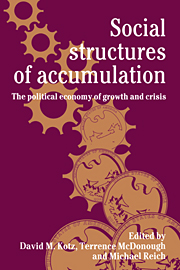Book contents
- Frontmatter
- Contents
- List of contributors
- Introduction
- Part I The theory of social structures of accumulation
- Part II History, institutions, and macroeconomic analysis
- 6 The construction of social structures of accumulation in US history
- 7 The financial system and the social structure of accumulation
- 8 Alternative social structure of accumulation approaches to the analysis of capitalist booms and crises
- 9 The politics of the US industrial policy debate, 1981–1984 (with a note on Bill Clinton's “industrial policy”)
- Part III Class, race, and gender
- Part IV The international dimension
- Afterword: New international institutions and renewed world economic expansion
- Comprehensive bibliography on the SSA approach
- Index
7 - The financial system and the social structure of accumulation
Published online by Cambridge University Press: 08 October 2009
- Frontmatter
- Contents
- List of contributors
- Introduction
- Part I The theory of social structures of accumulation
- Part II History, institutions, and macroeconomic analysis
- 6 The construction of social structures of accumulation in US history
- 7 The financial system and the social structure of accumulation
- 8 Alternative social structure of accumulation approaches to the analysis of capitalist booms and crises
- 9 The politics of the US industrial policy debate, 1981–1984 (with a note on Bill Clinton's “industrial policy”)
- Part III Class, race, and gender
- Part IV The international dimension
- Afterword: New international institutions and renewed world economic expansion
- Comprehensive bibliography on the SSA approach
- Index
Summary
The theory of the social structure of accumulation (SSA) has been advanced to explain in general the alternating periods of long-term boom and bust in advanced capitalist economies and in particular the current problems of US capitalism. A social structure of accumulation consists of the institutional environment affecting capital accumulation. Over a period of roughly fifty years, a given social structure of accumulation initially promotes capital accumulation, but ultimately winds up hindering that process.
The theoretical model of the social structure of accumulation posits that the financial system plays a central role in the institutional environment affecting capital accumulation. As argued by Gordon et al. (1982, pp. 23, 25):
Among the most important institutions [that make up the social structure of accumulation] are the system ensuring money and credit, the pattern of state involvement in the economy, and the structure of class struggle … it is not unreasonable to distinguish between those institutions that directly and demonstrably condition capital accumulation and those that touch it only tangentially. Thus, for example, the financial system bears a direct relation whereas the character of sports activity does not. (emphasis added)
Nonetheless, the specific analysis of the role of the financial system in the postwar social structure of accumulation in the United States has remained relatively undeveloped. This chapter is an attempt to contribute to that analysis.
- Type
- Chapter
- Information
- Social Structures of AccumulationThe Political Economy of Growth and Crisis, pp. 133 - 145Publisher: Cambridge University PressPrint publication year: 1994
- 9
- Cited by

